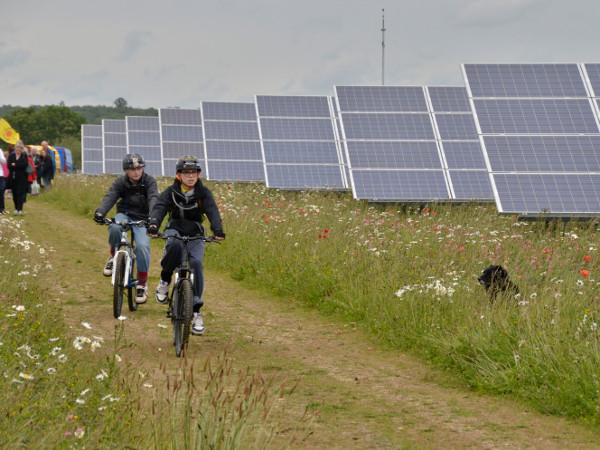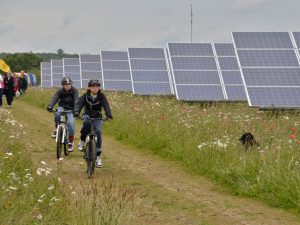“Local people investing in local people means that we can all muck in and put the work in to decarbonise where governments and large companies are slow to.” – Greg Jackson
Contents
What is community energy?
It’s ‘power to the people’ – literally, power (and sometimes heat) generation owned by groups of ordinary people. The basic idea of community energy is easy to grasp, but how it’s done exactly depends on local and national legislation / regulations at the time.
There are three aspects to community energy schemes:
- the renewable aspect: the production of green / low-carbon energy from wind, solar, and sometimes hydro, biomass or even the tides
- the co-operative aspect: they are owned and run by ordinary people rather than by corporations or the state
- the community aspect: they have a social mission of some sort

Community energy doesn’t have a long history, and neither does the renewable generation of electricity (although windmills, watermills and fire have been around for a long time). Wind power in Denmark represented the beginning of large-scale renewable energy generation towards the end of the 20th century, and it wasn’t long before around 50% of electricity in Denmark was generated from the wind – although it’s not that high now. The model in Denmark was community ownership – a small town or a group of farmers collectively owning a large turbine or two.
Baywind in Cumbria was the first community renewables project in the UK, set up in 1997 by a Swedish company, who ended up running out of money and leaving the project (consisting of five large wind turbines) to a local independent co-op. They did well, and have paid dividends of around 6% on average ever since. Baywind spawned Energy4All, an ethical developer, to take the Baywind model to other parts of the country. They were involved with forming the Westmill Co-op, with 5 x 1.3MW turbines on the Oxfordshire / Wiltshire border, owned by over 2000 people.

By 2010 there were 8 wind co-ops and 3 hydro co-ops in the UK, but since then, Feed-in Tariffs and the Renewable Heat Incentive have incentivised a wider range of technologies and a lot more schemes, including solar pv, smaller-scale wind, biomass – even anaerobic digestion and potentially, heat pumps. Now the community energy sector is booming, and Feed-in Tariffs have been the key to that expansion.
In the UK, almost all community energy schemes are ‘societies’ – either a co-operative society or a community-benefit society. A society is a legal entity (like a company or charity), administered by the Community Shares Unit of Co-operatives UK (the UK trade body for co-ops). Societies are able to run low-cost share offers to sell shares to the public (a limited company is not able to do this – it would have to become a plc). The offers are unregulated, so they don’t have to be individually approved by the FCA, which means that they are not overly expensive. Shares are not transferable (i.e. they can’t be sold), votes are allocated per person, and are not dependent on the number of shares owned. This isn’t very appealing to fly-by-night investors – it’s much more suitable for a community share offer.

So the combination of Feed-in Tariffs (enabling schemes to be financially viable) and societies (enabling schemes to raise money from the community) has meant that community energy has grown rapidly since 2010. There are many schemes at different stages of development all over the UK.
What are the benefits of community energy?
It means more renewable energy – which means lower carbon emissions and less pollution.
It increases the public’s understanding of renewables, for example providing accurate information on the viability of wind or solar farms.
There are often community benefits (the ‘social mission’) – surplus money can be put towards more traditional community ‘good works’. Westmill Co-operative give community grants for education and the arts, for example.
It allows people to take their money out of banks and put it somewhere in the local community where it will bring a good return (in the last few years, 4-7% has been typical).
It contributes to energy security.

It’s a place to innovate – with new business models as well as new technology. For example, JCC Biomass Co-op installed community-owned biomass boilers in a school in Leicestershire to provide cheap, green heat for the kids. Others provide energy efficiency information and training.
Community energy schemes are examples of community action outside the realm of the hopelessly idealistic. They are able to raise money and pay a decent rate of interest on it. They’re not stuck in the ‘green ghetto’ and they don’t have a particular ideology – they often attract people who just like their local area.
In summary, it’s clean energy that doesn’t involve the big six energy companies, investment that doesn’t involve the banks, the government gives you money to do it – and it’s not a dream.
What can I do?
Starting a scheme
First, chat to other local people who may want to do it with you. Then find a local group and go and chat with them. They may need a hand, in which case you’ll get valuable experience, and they’ll certainly be able to give you good advice to get you started. They can also tell you if there’s any start-up support in your part of the country. Community Energy England can provide more information and point you in the right direction; and here’s a guide to starting a community energy project from Sharenergy. There’s also Renew Wales and Local Energy Scotland who can put you in touch with people local to you who can give lots of useful advice. Look at other groups’ share offer documents – their core business model will be in there, and it will all be very useful to look over. You need to get the latest financial, technical and business information, as it goes out of date so quickly.
After you’ve got a plan, you can look for grant funding for a feasibility study. Search online, as different initiatives come and go, and are often different in England, Wales and Scotland.

Becoming a member of an existing scheme
If you want to invest in a community energy project, do a web search for community energy plus where you live. All schemes with share offers have a web presence. Also visit the websites of Sharenergy, Shares.coop and Ethex (who often list share offers and other ethical investments). Get yourself on their mailing lists for the latest offers. Membership of some schemes is locally prioritised, others are first come, first served.
Remember that it’s an ‘at risk’ investment, not a savings account. You can lose your money, and there’s no protection scheme. Make sure you understand what you’re buying into. You’re joining a co-op and therefore you get a say in how it’s run – and the more you take on, the more you’ll get out of it.
You also need to understand tax relief, which makes it viable for the average person. The situation is changing all the time, but as I write, in the UK, for every £1000 you put into a community energy scheme, the taxman will give you £300 back – which is a major incentive.

A common question is: ‘I own a bit of this turbine, so can I buy the electricity it generates?’ and the answer at the moment is no. So when a community energy co-op exports electricity to the grid, it’s paid around 6p per unit for its electricity – but the members of the co-op still have to buy electricity from the grid for around 15p per unit. Obviously, it would be better if the co-op could sell electricity directly to its members, but they would have to obtain an electricity supplier’s licence to do that – which is difficult. UK electricity licensing regulations are oriented towards the big players more than those of other European countries. ‘Licence Lite’ was introduced in 2009, but since then only one organisation has got one (the GLA) – it hasn’t turned out to be very ‘lite’ at all. Hopefully groups will be able to supply electricity to their members soon, as it has cross-party support (the right don’t like red tape, after all). This change might mean that the Feed-in Tariff could be removed, saving the treasury money, and providing people with a more local supply of electricity.
Specialist(s)
Thanks to Jon Halle of Sharenergy for information.
The specialist(s) below will respond to queries on this topic. Please comment in the box at the bottom of the page.

Simon Tilley, a chartered mechanical engineer, joined Hockerton Housing Project in 1995 after a background in manufacturing and sustainable development work. His main interests are in the energy aspects of building design, educational work including lecturing on the environmental science course at Nottingham Trent University and as the operations manager for Sustainable Hockerton’s community renewable systems.



1 Comment
I think I’d probably support anyone who convinces me that there will be no smart meters.